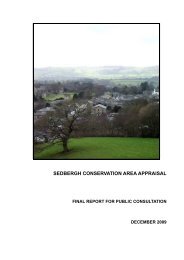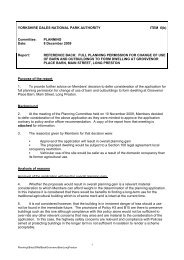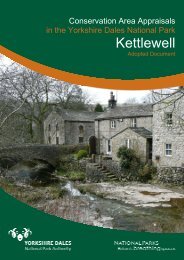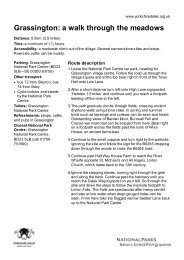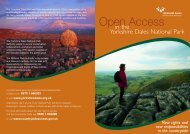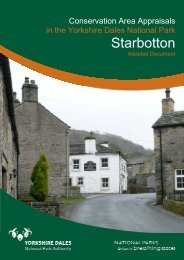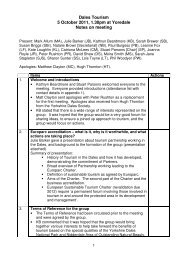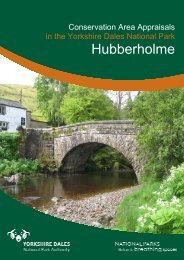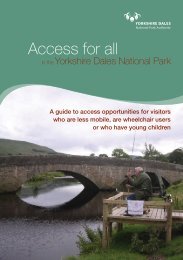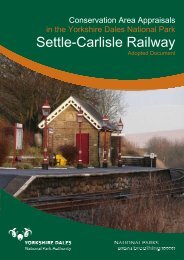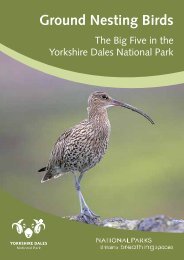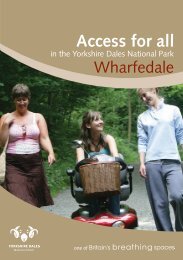12345Light, Jo (2000) ‘TheGeology of <strong>Langcliffe</strong> Parish’,http://www.langcliffe.net/Geology.html.Croll, Kate & Leigh, Joyce(2000) ‘The Timeline’,http://www.langcliffe.net/Timeline.html.Slater, Michael J (2009) ‘TheEarly History of <strong>Langcliffe</strong> inCraven’,http://www.langcliffe.net/Historyof<strong>Langcliffe</strong>.html.Slater, Nancy (2000) ‘ABackground to the SocialHistory of <strong>Langcliffe</strong>’,http://www.langcliffe.net/Background%20Social%20History.html.Slater, Michael J (2009)‘<strong>Langcliffe</strong> Manor: a shorthistory’, email to Gaby Roseon 23 October.There are no rocks of the Devonian period in <strong>Langcliffe</strong>, which lastedfrom 410 to 350 million years ago, as the Silurian rocks were thenprobably above sea level.The Lower Carboniferous period began around 350 million years ago,when sediments were laid down in a calm tropical marine environment. In<strong>Langcliffe</strong>, the exposed rocks of the Great Scar Limestone are aparticularly pure limestone, composed mainly of calcium carbonate andthe remains of corals, crinoids, foraminifera, algae and shell fish. Theyare light grey in colour and weather even paler, with obvious horizontalbedding planes and a well-developed system of joints, which are verticallines of weakness. Different layers display a rhythmic pattern from thechanging sea levels. In the parish, these immense deposits of Great ScarLimestone have resulted in massive features like high cliffs, scars andlimestone pavements. Caves with interconnecting passages and shaftsare also a common feature of this landscape.The geological succession then passes into the deltaic sediments of theYoredale Series. They show a typical rhythmic type of sedimentation witha gradual change from a marine to terrestrial environment.During a period of mountain building around 270 million years ago, thearea was again raised above sea level, and has mostly remained dry landsince that time. Only recent drift deposits from the last glacial period arefound on top of the Carboniferous beds.A more detailed description of the parish’s geology can be found on the<strong>Langcliffe</strong> website 1 .4.2 Historic Development and ArchaeologyThis section describes the origins, archaeology and historic developmentof the <strong>Langcliffe</strong> Conservation Area.a) Origins and Historic Development of the AreaOrigins. Worked bone found in excavations at Victoria Cave providessome of the earliest evidence for human activity in the <strong>Yorkshire</strong> <strong>Dales</strong>.There are earthworks indicative of late prehistoric and Romano-Britishsettlements in the <strong>Langcliffe</strong> parish, but no recorded finds or evidence forany pre-medieval settlement in the vicinity of the village.The following information has mainly been adapted from the <strong>Langcliffe</strong>website 2, 3, 4 , unless stated otherwise.Historic development. The village takes its name from the adjacentlimestone scars. The name is first mentioned in the Domesday Book of1086 as ‘Lanclif’. The parish of Giggleswick, in which <strong>Langcliffe</strong> lay beforeit became a parish of its own right in 1851, belonged at that time to RogerPoitou, although soon after the Percy family became its overlords. In1148, William de Percy founded the Cistercian Sawley Abbey on thebanks of the Ribble near Clitheroe, Lancashire.The Manor of <strong>Langcliffe</strong> was a territorial unit under feudal lordship,including arable and waste land, the village and further houses orfarmsteads 5 . Its development is closely tied to the histories of severallocal families.In 1221, Elias de Giggleswick, Lord of the Manor of <strong>Langcliffe</strong>, appealedto the Papal Legate about a corn mill built by the Cistercian monks ofFurness Abbey on his side of the river, taking away the custom from hisown mill. As a consequence, the monks had to hand the mill over. Inhope of buying salvation, Elias granted all his land in <strong>Langcliffe</strong> to SawleyAbbey in around 1240, making the abbot Lord of the Manor and14
56Slater, Michael J (2009)‘<strong>Langcliffe</strong> Manor: a shorthistory’, email to Gaby Roseon 23 October.Anon (2000) ‘The Mills’,http://www.langcliffe.net/<strong>Langcliffe</strong>%20Mills.html.proprietor of the former Furness corn mill, which is later referred to asHigh Mill.Following the Battle of Bannockburn, Scottish raiders ransacked<strong>Langcliffe</strong> in 1318. The village was then supposedly rebuilt half a milesouth of its original site.After the Dissolution of the Monasteries in 1536, Henry VIII rewarded SirArthur Darcy for helping to pacify the rebels in the north of England by‘selling’ him the <strong>Langcliffe</strong> Manor – i.e. granted in fee simple, then thesecurest form of tenure, as the king still remained the ultimate owner inthe feudal system. A year later, Sir Arthur bought all removablepossessions of Sawley Abbey which he had personally taken hold ofduring the uprising. In 1539, more <strong>Langcliffe</strong> land was transferred to himby his eldest brother. In 1591, thirty years after his death, the Manor andother land and properties were sold by his son Nicholas via ‘trustees’(feoffees) to a number of local people, in order to settle financial debts.Hence the tenants became ‘freeholders’ who traded their houses andland, with several families emerging as the major landholders. Thelordship of the Manor now rested with the villagers 5 .From the seventeenth to nineteenth centuries, much of the villagers’employment depended on the early-industrial mills nearby (figure 08).During the Middle Ages, there were two water-powered corn mills on the<strong>Langcliffe</strong> stretch of the River Ribble: Old Mill near the Stainforth borderand High Mill, both belonging to the monks of Furness. In 1784, High Millwas rebuilt for cotton-spinning, and a year later, <strong>Langcliffe</strong> Place wasconstructed as a home for the mill owners. Further south, the Shed wasadded, which became a weaving mill in the 1820s. In 1794, Old Mill wasadapted to paper-making. Between 1801 and 1841, <strong>Langcliffe</strong>’spopulation rose from 260 to 604. High Mill and the Shed were sold andclosed down by 1855, forcing many workers to desert the village,although when Lorenzo Christie re-opened them in 1861, the populationof only 376 started to dramatically increase again. From 1872 on, manypeople also depended on the employment at the Hoffmann Kiln at theCraven and Murgatroyd Lime Works, which was last fired in 1937. HighMill and the Shed finally closed in the early 1950s. The former was alsoconverted into paper making while the latter is now known as WatershedMill, an outlet store 6 . In 2006, the Old Mill closed after operating as apaper mill for over two centuries.Figure 08: Places ofemployment @ 1:50,000 (basedon Ordnance Survey © Crowncopyright. All rights reserved100023740 2009)1 the Shed/Watershed Mill2 High Mill/<strong>Langcliffe</strong> Place3 Old Mill4 Hoffmann KilnParishboundaryN34<strong>Yorkshire</strong> <strong>Dales</strong> <strong>National</strong> <strong>Park</strong>2Conservationarea1<strong>Langcliffe</strong> used to be a working-class community. Most men in the villagewere employed as farm servants, quarrymen or mill hands.15



